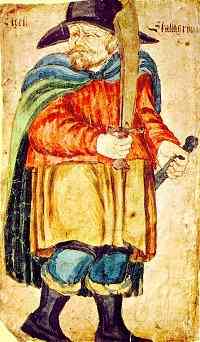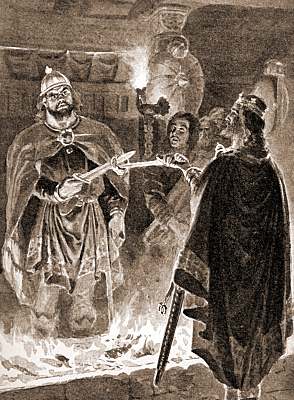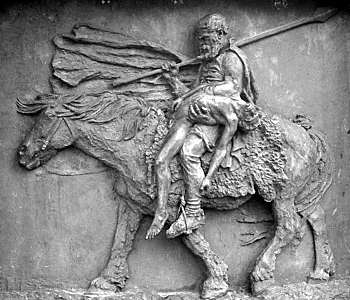
|

|
Viking-age Skaldic Poetry
|
Here's an example of a stanza of skaldic poetry taken from chapter 55 of Egils saga Skallagrímsson. The saga tells the story of Egill Skallagrímsson, an Icelandic warrior-poet who lived in the 10th century. In the saga, Egill composes and speaks this stanza: Hrammtangar lætr hanga hrynvirgil mér brynju Höðr á hauki troðnum heiðis vingameiði; ritmœdis knák reiða ræðr gunnvala bræðir gelgju seil á galga geirveiðrs, lofi at meira. This stanza, like much of the skaldic poetry, uses the dróttkvœtt meter (the heroic meter). Each stanza has eight lines, and each line has six syllables. Three syllables in each line must be stressed, and the last syllable must be unstressed. The lines are linked in alliterating pairs, and the first line of each pair must have two alliterating syllables. All lines must have internal rhyme. |
 |
Hrammtangar lætr hanga |
In the first couplet (shown to the left), the stressed syllables are underlined; the alliteration is boldfaced; and the internal rhyme is italicized. |
With all these rules, it's clear that a dróttkvœtt stanza is very demanding metrically; in fact, it is so demanding that normal word order was frequently shifted in order to make the meter come out right. So the first step in understanding a skaldic poem is to shift the words around into normal order. When placed in that order, the first half of the stanza becomes:
Brynju Höðr lætr hrammtangar hrynvirgil hanga mér á hauki troðnum heiðis vingameiði.
The next step is to understand the meaning of the words and of the kennings. Here's a literal English translation of the stanza:
Höðr of the mailcoat lets the halter of the arm hang on my hawk-trodden
hawk-gallows;
I know how to make the
pin-string of the shield-tormentor ride the gallows of the spear-storm.
The feeder of the battle-hawk
enjoys the greater praise.
 |
What's it really mean?
Egil and his brother Þórólf fought in the service of King Aðalsteinn in the Battle of Vinheath (circa 927). Þórólf died a meaningless death in the battle, in large part caused by a military blunder by Aðalsteinn. Egil survived and was responsible for the victorious conclusion to the battle. Following the battle, at the feast in the king's hall, Aðalsteinn and Egil sat across from each other. Egil was grief-stricken and angry. He was dressed in full battle kit and was fully armed. Using his most fearsome visage, he glared silently at the king. Repeatedly, Egil partially unsheathed his sword, then thrust it back in its scabbard. To defuse the situation, the king removed a gold ring from his arm, placed it on the point of his sword, and offered it to Egil across the hearth. Egil picked up the ring with his sword, and put it on his arm, thus restoring the balance of respect and recognition. Mollified by the king's gift and the respect it signified, Egil joined in the feast by taking up the drinking horn and by speaking this verse:
The warrior lets the ring hang on my arm; |
The final step for the translator is to turn this very plain English prose back into something that approximates the form and tone of the original verse. Here, on the left and right, are two different translators' attempts to put this verse in English:
It was the warrior's | The King in his coat
work, to hang this gold band | Of steel sets this gold coil,
round an arm where the hawks ride | This ring, on my right arm
ready to do my will. | Where falcons have rested;
|
And see how I make my sword | The gift hangs glowing,
summon the ring to its | My arm its gallows:
arm. There's skill to this. But | Honour was earned
the prince claims greater praise. | By the feaster of eagles.
Despite all this lengthy discussion, I haven't even touched upon the sophistication that lies yet one layer deeper in the verse, such as the reference to Höðr, the god who slew his brother, Baldr.
Many other meters were used in Norse poetry, as can be seen by surveying the poetry. Even to the untrained ear, the differences in rhythm, rhyme, and alliteration are apparent. Here are two brief examples, both from Egils saga Skallagrímsson.
The first example is taken from Höfuðlausn (Head Ransom) in chapter 60 and is written runhent meter. Egill saved his own life when he was in the power of King Eiríkr blóðøx Haraldsson in York by composing this poem overnight and reciting it to the king the next morning. It is simply a poem of praise to the king, in drápa form, having repeated "refrains" throughout the poem.
Vestr fór eg um ver | West over water I fared en eg Viðris ber | bearing poetry's waves to the shore munstrandar mar, | of the war-god's heart; svo er mitt of far. | my course was set. Dró eg eik á flot | I launched my oaken craft við ísa brot. | at the breaking of ice, Hlóð eg mærðar hlut | loaded my cargo of praise míns knarrar skut. | aboard my longboat aft. Buðumst hilmir löð, | The warrior welcomed me, þar á eg hróðurs of kvöð. | to him my praise is due. Ber eg Óðins mjöð | I carry Odin's mead á Engla bjöð. | to England's meadows. Lofað vísa vann, | The leader I laud, víst mæri eg þann. | sing surely his praise; Hljóðs biðjum hann | I ask to be heard, því að hróðr of fann. | an ode I can devise.
The second example is taken from Sonatorrek (On the Loss of My Sons) in chapter 78, a poem in kviðuháttr meter in honor of Egil's two sons, Böðvarr and Gunnarr. Böðvarr died in a boating accident. Egill was so grief-stricken that he locked himself in his bed-closet, intending to starve himself to death. He was tricked into taking nourishment by his daughter Þorgerðr, and she subsequently convinced him to compose a poem in honor of his recently deceased sons. The poem is exceptionally powerful and lyrical. The sculpture shown to the right depicts Egill carrying Böðvarr's body back from the shore and is located at the burial mound of Böðvarr and his grandfather, Skallagrímr. |
 |
Nú er mér torvelt. | Now my course is tough: Tveggja bága | Death, close sister njörva nift | of Odin's enemy á nesi stendr. | stands on the ness: Skal eg þó glaður | with resolution með góðan vilja | and without remorse og óhryggr | I shall gladly heljar bíða. | await my own.
|
|
©2000-2025 William R. Short |
This discussion of skaldic poetry is derived from Else Roesdahl's The Vikings. The translation of the first verse appearing in the left column is by John Lucas, taken from Roesdahl's volume. The translation in the right column is by Hermann Pálsson and Paul Edwards from their translation of Egils saga. The remaining two translations are by Bernard Scudder from The Complete Sagas of the Icelanders.